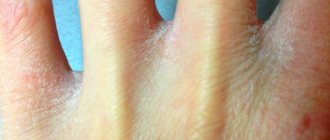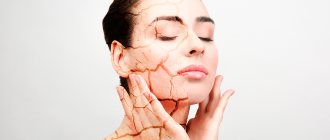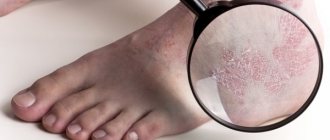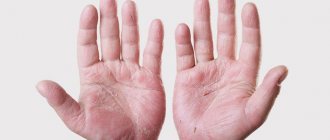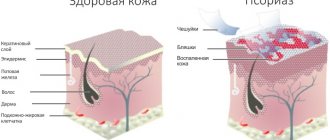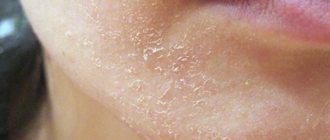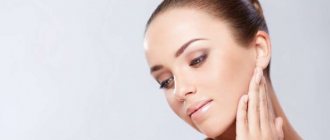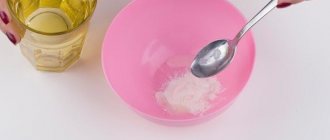Causes
The main causes of injury to the interdigital space are mechanical damage due to improper care and fungal infections (mycoses). Provoking factors for the development of cracks in the feet are:
- uncomfortable shoes made from low-quality materials;
- long-term wearing of open shoes (exposure to dust, dry air, mechanical irritation, especially from flip-flops);
- long-term use of hosiery made of synthetic materials;
- non-compliance with the rules of personal foot hygiene;
- neglect of cosmetic care;
- walking barefoot;
- visiting public places;
- high load on the legs (teachers, salespeople, doctors, athletes).
- Infection with foot fungus occurs due to a combination of non-compliance with personal hygiene rules and microtraumas of the skin between the toes.
Also, why the skin of the feet cracks can be explained by the presence of such pathological conditions of the body as: dyshidrosis of the feet;
- deficiency of vitamins A, E and B;
- pathology of the endocrine system (obesity, diabetes, thyroid disease);
- bacterial infection;
- pathology of the vessels of the lower extremities (impaired blood supply due to damage to the arteries or blood outflow due to varicose veins);
- allergies (atopic dermatitis, eczema, neurodermatitis);
- plantar psoriasis;
- keratoderma.
Before treating a crack between your toes, the exact cause should be determined. Sometimes you cannot do without medical help; this applies to injuries that are long-term non-healing and resistant to therapy.
Prevention
Almost any skin defect can be prevented, and cracked toes are no exception; the main thing is to follow the simplest preventive measures. The first thing you should worry about is regular hygiene procedures. Also, when washing your feet, you need to make sure that the water is soft, or it should be softened first. Soap and other detergents should be natural based, preferably containing glycerin.
After washing, fingers and feet should be wiped dry so that there is no moisture left between the toes, where the first minor cracks often appear. It is also necessary to regularly apply a nourishing or moisturizing cream to the skin.
It is imperative to monitor the temperature and avoid sudden changes. Feet should always remain warm. You should always remember that untreated cracks in the fingers, sooner or later, will lead to serious problems, including the development of a fungal infection, which can easily be transmitted to other people. Also in those situations. When, after all the tried remedies, the skin condition does not improve, you should definitely visit a doctor, because the problem may lie in a serious disease, which is still in its early stages and does not give clear symptoms.
The variety of cosmetic defects of the skin of the toes does not include a very large number of its uncomfortable conditions. But their prevalence is a more pressing question. Dry skin and cracked toes caused by this is a common problem that every person could face. The reasons for this condition can be very different, as well as the consequences. In some situations, the problem should be treated urgently, in others, simply changing your shoes is enough. The main thing is to accurately understand the cause-and-effect relationship in order to correctly approach the solution to the problem.
Symptoms
Symptoms of skin damage between the toes may vary depending on the cause that caused them. So, with dyshidrosis it is noted:
- increased sweating of the feet;
- diaper rash and maceration;
- redness;
- burning at the site of injury;
- spread of the process to neighboring areas.
Article for you:
Treatment of trichomoniasis in women drugs scheme
In case of fungal infections, the clinical picture of the lesion is characterized by the following signs:
- a dry area forms at the site of the lesion;
- itching, and as a consequence the presence of scratching;
- the appearance of one or more bubbles that burst;
- formation of erosions, peeling;
- with candidiasis there may be a white coating;
- unpleasant odor;
- damage to the nails (they become yellow, thickened, and crumble easily).
With bacterial inflammation between the fingers, the presence of such characteristic symptoms as:
- bright redness;
- soreness;
- swelling;
- increase in local temperature;
- there may be purulent discharge.
When affected by allergic origin, keratoderma or psoriasis, the cracks are deep, occur against the background of severe hyperkeratosis (excessive keratinization of the epidermis), may be accompanied by itching, the skin peels off in layers, and the affected areas may bleed.
For additional diagnostics, a dermatologist may prescribe a culture of a scraping from the skin separated from a crack, perform a biopsy of a small area for histological examination, and schedule a consultation with a related specialist.
Treatment of cracks caused by fungus
One of the most common causes of skin defects is fungus. It affects the epidermis and nails. The feet begin to peel, itch, there is a burning sensation (not always), the skin begins to peel off. An unpleasant odor is detected from the feet. When the nail plate is damaged, the nails become yellow or gray and begin to break off.
Against the background of a fungal infection, there are usually many cracks, they are deep, and cause a lot of pain. If there is such a clinic, then this will mean a fungus. For therapy, it is necessary to establish the type of pathogen in order to select the most effective method of treatment.
Treatment for men and women is complex; it is necessary to influence the fungus and use drugs that accelerate the healing process.
Local preparations
Local medicines are represented by means for external use. They allow you to act directly on the lesion.
Good drugs are presented in the table:
| Name of medicine | Description |
| Quinofungin | The drug is prescribed for superficial skin fungus and interdigital lesions. When the nail plate is affected, the effect is small. It has a fungicidal effect - aimed at destroying fungal pathogens. Available in the form of powder, in a pack of 50 g. Use twice a day, applied to pre-washed skin. Can be used to treat shoes and socks. Contraindications include hypersensitivity. Sometimes during treatment, patients experience slight redness of the skin. |
| Anmarin | Prescribed for the treatment of fungus between the toes, for infections that are accompanied by the formation of cracks and weeping. The product is effective against various types of fungi and has a moderate antibacterial effect. Available in gel form. Apply to affected areas up to 3 times a day. Before each use of the product, wash the limbs and wipe dry. Apply carefully, do not rub too hard. The course of treatment lasts up to a month. Contraindications include individual intolerance to the composition. |
| Clotrimazole ointment. | A medicine with a wide spectrum of effects. Destroys different types of fungi. The ointment is applied in a thin layer 2-3 times a day. It helps against onychomycosis, but the effect is insignificant. Treatment lasts a month. |
Before using antifungal drugs, it is recommended to treat the lesions with antiseptics. Chlorhexidine is often used. It can be replaced with Miramistin or hydrogen peroxide.
Tablets for internal use
Tablets are combined with local agents.
Their appointment means that the patient’s case is complex and requires influence from the inside.
Prescribed for mycosis of the feet, interdigital space, against the background of damage to the nail plates by fungal pathogens.
Important addition: Why do my fingernails hurt after removing polish and when pressed?
All antifungal tablets are divided into two large groups:
- Medicines that destroy (kill) pathogens. These are Terbinafine, Natamycin, naftifine.
- Agents that inhibit the growth and reproduction of pathogenic microorganisms. Representatives of this group include Itraconazole and Ketoconazole.
Effective tablets against fungal infections are toxic, so their help is resorted to only in difficult cases. Let's take a closer look at several drugs:
| Name | Description |
| Natamycin | A broad-spectrum antifungal agent containing the substance natamycin. Tablets are not prescribed during pregnancy, hypersensitivity, or tuberculosis of the skin. The dosage for an adult is selected individually, but not more than 400 g per day. Among the possible side effects, the abstract notes digestive disorders, pain in the epigastric region, and vomiting. |
| Ketoconazole | One tablet contains 250 mg of the active substance ketoconazole. The product provides fungicidal and fungistatic effects. The tablets should be taken with meals; the dosage for an adult is 200 mg per day. If necessary, increase to 400 mg. Not prescribed during pregnancy, lactation, or childhood. A toxic drug that often leads to the development of negative phenomena. |
When nails are affected, tablets from the azoles or allylamines group are prescribed. Due to prolonged use, they accumulate in the nail plate and continue to act for several weeks after stopping the medication.
Good tablets are Terbinafine and Rumicosis.
General recommendations
The health of your feet largely depends on the quality of foot care and the correct selection of shoes. In order to quickly and effectively cure cracks, as well as to prevent their recurrence, it is important to follow the following recommendations:
- wash your feet daily (in the evening) with soap and then apply a caring cream;
- selection of high-quality shoes based on size, last comfort, heel height;
- restriction of wearing open shoes;
- in public places (swimming pools, baths, saunas, gyms) use individual replacement shoes;
- take foot baths with cosmetics twice a week, use foot belongings;
- exclude long-term wearing of nylon and synthetic hosiery;
- If possible, perform a professional pedicure at least once a month;
- if necessary, use compression stockings;
- Carry out daily gymnastics and self-massage of the feet;
- control blood sugar levels;
- include in your diet foods rich in vitamins A, B, E (cereals, cereals, eggs, liver, sea fish, herbs, vegetable oils).
Article for you:
Appendicitis - symptoms and causes in women, how to diagnose
In most cases, following these recommendations will effectively combat dryness, excessive sweating, and unpleasant foot odor. Compliance with simple rules of hygienic care for the skin of the feet becomes a favorable basis for drug treatment if necessary.
Treatment of dry and painful cracks
Dry cracks that cause a lot of pain should be treated with preparations containing retinol, tocopherol and vitamin D. Before use, it is recommended to take a bath with herbs.
Shostakovsky Balm
An effective and inexpensive drug with many positive reviews. It provides antibacterial and antiseptic effects. The active substance in the composition is vinylin. It accelerates regeneration processes and relieves pain. After applying the balm, a thin film is created that protects cracks from the penetration of fungi and bacteria.
Shostakovsky balm is not used during pregnancy, for pathologies of the liver, kidneys, or gall bladder. Cannot be used during lactation or against the background of an allergic reaction.
Directions for use: Apply balm to a napkin and apply to chapped skin. Frequency of application 2-3 times a day. Treatment lasts until the skin is completely healed.
Solcoseryl
The basis of the topical agent is hemoderivative of calf blood. The effect of the drug is to activate tissue metabolism, which promotes accelerated regeneration of damage to the skin.
It is recommended to use for the treatment of wounds that do not heal for a long time, for trophic skin disorders, burns, frostbite. Before use, the affected area is treated with an antiseptic solution.
Solcoseryl is applied in a thin layer. Frequency of application – up to three times a day. Negative phenomena are possible in the form of an allergic reaction - rash, hives, itching and burning. Do not use if you are hypersensitive to benzoic acid.
The advantage of the drug Solcoseryl is the effectiveness and safety of the composition. Can be used during pregnancy, lactation, and used to treat children and the elderly.
Drug therapy
Treatment of cracks between the toes, if the causes of the damage are not due to defects in care, should be carried out with the help of medications.
In this situation, local therapy with soft forms, powders, and liquids is most acceptable. For fungal foot infections, ointments and creams containing an antimycotic can be used:
- Lamisil (386-861r).
- Terbinafine (56-149r).
- Pimafucin (235-538r).
- Nizoral (RUR 340-633).
- Mikoderil (297-635 rubles).
In case of damage of bacterial origin, products containing antibacterial substances can be used:
- Levomekol (81-113r).
- Oflomelid (97-140r).
- Levosin (69-98r).
- Baneocin (224-377r).
- Drapolene (201-282r).
Antiseptic solutions are used to treat the skin:
- Chlorhexidine (9-39r).
- Furacilin (36-61r).
- Betadine (148-380r).
- Miramistin (131-316r).
- Octenisept (214-300r).
In complex therapy for skin damage between the fingers, drugs that promote rapid healing and tissue renewal can be used, such as:
- Bepaten (268-641r).
- Solcoseryl (149-210r).
- Methyluracil (42-60r).
- Radevit Active (295-439 rubles).
- Pantoderm (167-237r).
For cracks of allergic origin, psoriasis and keratoderma, therapy with ointments containing glucocorticoids may be required:
- Avecort (188-264 rubles).
- Beloderm (175-255r).
- Cutivate (204-307r).
- Fluorocort (138-193r).
- Elokom (334-474r).
Antibacterial and hormonal agents should be prescribed by a doctor after excluding other pathologies. If the integrity of the skin is damaged due to impaired blood supply or diabetes mellitus, treatment should be comprehensive, aimed at stabilizing the underlying disease. Self-medication in this case is not allowed.
Mechanism of occurrence
The negative condition of the epidermis, in which the skin on the toes bursts, can be caused by a number of reasons. They are conventionally divided into two main categories, based on the pathogenesis of disease factors.
The first category includes the result of careless actions of the patient himself. The reasons for dry skin in this situation are:
- applying excessive force in the process of removing keratinized areas using pumice;
- wearing unsuitable synthetic shoes that disrupt the water-lipid balance;
- violation of the drinking regime - the skin may simply not have enough water;
- active use of alcohol-containing deodorants and various means against sweating feet;
- often the skin peels due to stressful conditions and overstrain of the nervous system;
- frostbite, sunburn;
- frequent skin contact with household chemicals;
- age-related changes occurring in the body;
- violation of diet, sleep and rest.
The second category is various diseases that result in cracking of the skin on the toes. It includes congenital and acquired diseases of the child, their acute or chronic phase. Increased dryness of the skin, various progressive infectious conditions, genetic inheritance, allergic reaction - medicine has a lot of such causes. Therefore, independent struggle with the disease for many in this case presents certain difficulties.
How to restore cracked skin at home
Dry skin on the fingers and heels can crack without mechanical impact, then people turn to traditional medicine for help, which recommends many remedies. To eliminate fungus, feet are washed with laundry soap, which disinfects and relieves inflammation.
- Baths with the addition of soda reduce the depth of cracks and soften the skin. You should keep your feet in water for 30 minutes, then dry them and apply moisturizer.
- Pure Vaseline is an excellent folk remedy for treating cracks under the little toe. To achieve the effect, you need to apply a thick layer of Vaseline and put on socks at night.
- Liquid honey is applied to problem areas and a bandage is made on top. A few nights - and the skin of the feet will return to smoothness.
- At home, you can heal wounds yourself with alcohol and iodine with the addition of acetylsalicylic acid. The components are mixed until smooth. The resulting mixture should be placed in a dark place for a day, then lubricate the problem area several times a day. Alcohol dries and relieves inflammation; it is necessary to additionally lubricate the feet with cream.
Traditional recipes for treating cracked heels
- Apple vinegar . Mix 1:1 water with apple cider vinegar, moisten your feet well with this mixture and wrap them in gauze and leave them overnight. In the morning, wash well with pumice and lubricate with nourishing moisturizer.
- Onion ointment. Finely chop two medium onions and pour a glass of heated sunflower oil (not refined) over them. Heat this mixture in a frying pan and fry the onion until golden brown. Then add a couple of tablespoons of melted beeswax. Mix the entire mixture thoroughly, strain, pour into a glass container and store in the refrigerator. Lubricate your feet with it before going to bed for 1-2 weeks until the cracks in your feet and toes are eliminated.
- Herbal baths. per liter of water a couple of tablespoons of a mixture of dry nettle, sage and chamomile herbs. After steaming your feet in a not-hot bath, let them dry and lubricate them with a nourishing moisturizer. An excellent preventative.
As for the treatment of foot fungus, it is better to consult a dermatologist and take a skin smear to clarify the diagnosis.
Expert opinion
Sakania Luiza Ruslanovna
Dermatovenerologist, cosmetologist, trichologist
Ask a Question
As a rule, in a normal case, treatment is with corticosteroid ointment and antibacterial lotions.
In folk medicine, they offer the following ways to solve the problem:
- glycerin mask;
- oil-based mask;
- wax mask;
- mumiyo.
Glycerol
First of all, it is worth remembering such an excellent remedy for restoring the properties of the epidermis as glycerin. For complete recovery of the skin, no more than five procedures will be required.
To prepare the mask, you need to take two tablespoons of water (warm), and add a tablespoon of regular flour into it, then add a spoonful of honey and 2 tablespoons of pharmaceutical glycerin. The mass needs to be mixed thoroughly (it should look like dough), and if it turns out liquid, then you can add a little flour.
Then the resulting substance is divided into two parts and applied to the affected areas, leaving for 20 minutes. After time, the mask is washed off (you can even use milk, not water), which will help moisturize the skin more.
Please also note that glycerin can be replaced with any fat, but then all ingredients should be used in equal proportions, and the mask should be secured with a bandage and left overnight. After such procedures, the skin will stop bursting and cracking.
Oils
All kinds of vegetable oils perfectly moisturize the skin of the feet and fingers, but it is best to give preference to olive oil, sea buckthorn or cold-pressed castor oil. If they are not available, then regular unrefined sunflower oil will do.
The procedure involves applying oil to damaged skin, after which socks made of natural fabric are put on the feet. To achieve better therapeutic results, liquid vitamins A and E can be added to the oil.
Wax
The presented recipe is rightfully considered the best remedy for treating cracked fingers. To prepare a mask, you need to take natural beeswax and melt it. As soon as the mass becomes liquid (make sure it is not hot), the damaged fingers are dipped into it and wait until the wax hardens.
The result is a kind of thimble or cap. Then you need to put on cotton socks and leave the wax on your fingers for 12 hours, after which the caps are removed. And the skin is lubricated with nourishing cream. Treatment must be performed daily until the cracks are completely gone.
It is also worth remembering that hot wax does not leave burns, so there is no need to worry about the skin or worsening the condition; the most important thing is to quickly remove your fingers from the mass.
Mumiyo
If cracks or peeling appear on your fingers, you can prepare a medicinal solution based on mumiyo at home, which differs from the above remedies in its excellent ability to stop bleeding and fight bleeding wounds.
The recipe is quite simple and involves the use of several mummy tablets and warm water (you need to combine and dissolve the ingredients).
Next, a regular foot bath is done, that is, the limbs are lowered into the water and left for 15 minutes, after which they are pulled out. And they wipe it off. Daily procedures are allowed until the cracks are completely healed.
BF-6
In situations where the cracks have become too deep, and there is already pain and discomfort, medical glue BF-6, which is characterized by the ability to seal wounds, will help improve the condition.
You just need to apply the product to the crack and wait for it to dry, after which a protective film is formed that prevents infection and promotes wound healing. However, remember that before using glue, the skin around the crack should be treated with a rich cream.
